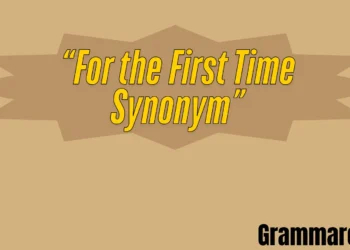Clarity counts in both expert communication and daily talks. The statement “I just want to make sure” is often used. Seeking confirmation, clearing a point, or double-checking crucial details is a courteous, straightforward approach. Whether you’re verifying a coworker’s deadline or checking to be sure someone grasped your message, this saying aids in bridging the intent-to-understanding divide. Though it sounds kind and thoughtful, its application timing and style might also show hesitation or doubt. This guide will examine the tone, perceived meaning, best times to say this word, and occasions when it would be wiser to speak something different.
What Does “I just want to make sure” Mean?
Expressing a need to verify or clear something before proceeding, the phrase “I just want to make sure” Often indicates that you’re trying to prevent mistakes or misunderstandings, signaling meticulousness and attention to detail. Typically, this involves double-checking instructions, verifying facts, or seeking comfort in either a personal or professional context.
Is saying “I just want to make sure” professional/polite?
Yes, particularly when said or written respectfully, the remark is typically regarded as professional and cordial. It demonstrates your careful, active behavior. In business communication, it shows diligence and responsibility. Though it is best used carefully, as overuse or bad timing can make it seem uncertain or too timid.
Advantages and Disadvantages of “I just want to make sure”
Advantages of Using “I Just Want to Make Sure”
- Encouragement of clarity helps to prevent errors and misunderstandings.
- Shows care about getting things right.
- Professional tone is courteous and considerate, especially in meetings or emails.
- Invites clarification and debate; encourages honest communication.
- Develops confidence by strengthening your reliability and attention to detail.
Disadvantages of Using “I Just Want to Make Sure”
- Sound hesitant might signal uncertainty or a lack of confidence.
- Repeating usage can be annoying. Too often, use might appear prudent.
- May delay movement; continuous checking may slow down decisions.
- Not forceful; lacks directness in certain situations necessitating tenacity.
- Context-dependent: It could be considered extraneous in quick-paced surroundings.
When should “I just want to make sure” be used?
Utilize this phrase while double-checking facts, approving next steps, or explaining directions. Follow-ups, project assessments, and meeting alignment are all greatly helped by it. You can gently clarify without appearing contentious or too straightforward. It works well. Perfect in cooperative, courteous settings.
What tone does “I just want to make sure”?
The mood is polite, considerate, and somewhat wary. It communicates double-checking before acting and attentiveness. It strikes a balance between being neither too aggressive nor too gentle, making it suitable for academic discussions, customer support, professional meetings, and even personal chats.
When should you avoid saying “I just want to make sure”?
In high-pressure or rapid situations when decisiveness is crucial, avoid using this phrase. Also, if you have already confirmed something many times, repeating this phrase may come off as superfluous or uncertain. When speaking to someone who expects assertiveness right away, it’s best to avoid it, as it could undermine your message.
Professional Alternatives of “I just want to make sure”
1. Assist me in ensuring that we are in line.
Meaning: You’re inviting teamwork to guarantee mutual knowledge.
Definition: A teamwork-oriented phrase employed to verify alignment.
Explanation: Encouragements of shared responsibility and candour are provided here.
Example: Before we go our separate ways, assist me in ensuring we match on the action items.
Tone: respectful, cooperative
Best Use: Project syncs, planning meetings.
Worst Use: Official talks might sound too informal.
2. Confirmations are crucial.
Meaning: You’re stressing the need to confirm anything.
Definition: A statement used when accuracy is critical.
Explanation: Clarity’s signals will help to avoid upcoming problems.
Example: Verify that the deadline has not changed.
Tone: Responsible, serious tone
Best Use: High-stakes labor and significant judgments.
Worst Use: Informal conversations—it can appear too burdensome.
3. Here I am verifying the facts…
Meaning: Confirming correctness will help you along.
Definition: A technical-sounding expression suggesting double-checking.
Explanation: Assists others in understanding that you are diligently working.
Example: I am verifying the information here to ensure it matches our data.
Tone: Methodological; professional
Best Use: reporting, analytics, data review.
Worst Use: Creative brainstorming—it can choke flow.
4. Before going, I want to shut this down.
Meaning: Before moving on, you have to have the last confirmation.
Definition: A precise, decisive phrase.
Explanation: Securing an agreement prevents work.
Example: I want to lock this down before moving on to phase two.
Tone: Strong, crisp
Best Use: Deliverables for clients, milestone evaluations.
Worst Use: Early-stage talks could seem premature.
5. Let’s quickly verify.
Meaning: You are advocating for a rapid verification process to ensure correctness.
Definition: A time-efficient prompt for verification.
Explanation: Balances speed with accuracy.
Example: Let’s double-check the sums before we send the invoice.
Tone: efficient, pragmatic
Best Use: agile teams, task reviews, meetings.
Worst Use: Deep analysis— may seem rushed.
6. Though I should confirm, I hope you wouldn’t mind.
Meaning: You’re softening a request for clarity.
Definition: A courteous technique of verifying anything.
Explanation: Reduces pressure and promotes empathy.
Example: I trust you don’t mind my confirming, but we’re adhering to the original version, right?
Tone: modest, loving
Best Use: Cross-departmental emails, with senior management being the top users.
Worst Use: Legal contracts: It’s far too informal.
7. In your time, I want to guarantee…
Meaning: You are agreeing on something to prevent needless effort.
Definition: A thoughtful statement that respects the schedules of the other person.
Explanation: Establishes a positive reputation by presenting your verification as effective.
Example: Respect for your time motivates me to make sure we are prepared to move forward.
Tone: Thoughtful, respectful
Best Use: stakeholder or client contact.
Worst Use: Low-stakes internal conversations may seem overdone.
8. Simply seeking respect for the process and clarity…
Meaning: While double-checking something, you are respecting the agreed-upon steps.
Definition: One sentence affirming driven values.
Explanation: Reassures others that you’re not bypassing steps.
Example: Want to honor the process and clarify the order of approvals.
Tone: Process-oriented, diligent
Best Use: Cross-functional work, project management.
Worst Use: Too organized, casual group chat.
9. Your help in confirming this is greatly valued.
Meaning: You are expressing thanks in advance for clarification.
Definition: A phrase confirmatory of gratitude.
Explanation: Encourages collaboration while showing respect.
Example: Thanks so much for assisting me with confirming this timeline.
Tone: Professional, appreciative
Best Use: client connections, email threads.
Worst Use: Fast-paced meetings: they slow down the rhythm.
10. Your feedback matters; I just wanted to see…
Meaning: You’re seeking clarification by agreeing with someone’s opinion.
Definition: A human-centered approach to verification.
Explanation: Encouragement of mutual respect and active participation.
Example: I value your input; I just wanted to see whether this matches your suggestion.
Tone: Appreciative and inclusive
Best Use: Peer interaction, feedback loops.
Worst Use: Hurried project delivery; it might derail speed.
11. I wish to prevent any misinterpretation.
Meaning: You are clarifying something to avoid misunderstanding later.
Definition: A sentence affirming preventive measures.
Explanation: Exhibits vision and care for communication quality.
Example: To prevent any misunderstandings, can you confirm we’re using version 2.0?
Tone: Prudent, responsible
Best Use: Shared tasks, written directions.
Worst Use: Repetitious follow-ups, which might seem like second-guessing.
12. Please let me confirm this one last time.
Meaning: You’re softly asking for clarity.
Definition: A courteous reconfirmation phrase.
Explanation: Diligence is shown without being overbearing.
Example: Hope it’s fine if I confirm this one more time—did the client accept slide 5?
Tone: Humble, prudent
Best Use: Repeated client contacts; high-stakes approvals.
Worst Use: Low-risk problems; it can sound agitated.
13. I’m being cautious; just ensuring…
Meaning: A quick check-in will let you justify your carefulness.
Definition: A self-aware confirmation phrase.
Explanation: Softens the act of double-checking by taking ownership of it.
Example: I’m checking to see that we are registered in the appropriate venue.
Tone: Humble, considerate
Best Use: Safety inspections, customer delivery, and event planning.
Worst Use: Contexts where confidence is expected.
14. Thanks for your patience; simply clarifying…
Meaning: Before correcting something, you are demonstrating gratitude.
Definition: A check combined with a polite thanks.
Explanation: Lowers irritation when more clarity is required.
Example: Thank you for your patience; just clarifying which format you prefer.
Tone: Grateful, polite
Best Use: Follow-ups, client service, team management.
Worst Use: Timesensitive or casual conversations.
15. I want to grasp this completely…
Meaning: Your need for clarity is being stressed.
Definition: A transparent and judiciously worded phrase.
Explanation: Shows that you intend not to make assumptions.
Example: Before completing the proposal, I want to understand this completely.
Tone: Inquisitive and respectful
Best Use: Onboarding, project discovery, training
Worst Use: Time-critical activities—it may postpone choices.
16. Thought I should double check…
Meaning: A gentle reminder that you’re reconfirming something.
Definition: A quick, humble expression used for double-checking.
Explanation: Maintains a cordial and non-invasive approach.
Example: Thought I’d double-check—are we still suitable for 3 PM?
Tone: Friendly, casual
Best Use: Group coordination, team chats.
Worst Use: Client-facing reports—it’s overly lax.
17. Might I examine something swiftly?
Meaning: You stop momentarily to verify a fact.
Definition: A conversational phrase for a quick explanation.
Explanation: Indicates that the disruption will be pretty modest.
Example: Can I check one thing real fast? Is the payment plan monthly or quarterly?
Tone: Casual and effective
Best Use: Calls, impromptu conversations.
Worst Use: Formality—too casual.
18. One final item to verify…
Meaning: You are examining a final detail.
Definition: Before ending, a wrap-up phrase to bind loose ends.
Explanation: Helps you to dodge last-minute surprises.
Example: One more thing to be sure of—does the webinar feature a Q&A?
Tone: Crisp, concentrated
Best Use: For last checklists and prep meetings.
Worst Use: Initial briefings; they seem too polished too soon.
19. Crossing the t’s and dotting the i’s…
Meaning: You are verifying that every detail is correct.
Definition: A descriptive approach to represent thoroughness.
Explanation: Offers detail, checking a light, upbeat attitude.
Example: Crossing the t’s and dotting the i’s right before submission.
Tone: Light, details-oriented
Best Use: Editorial work, wrap-up stages.
Worst Use: It may confuse nonnative English speakers.
20. Can I check something before I assume?
Meaning: You stop misinterpretation.
Definition: A simple statement that demonstrates your preference for questioning over assuming.
Explanation: Promotes honest, judgment-free confirmation.
Example: Before I suppose, can I examine anything about the shipping cost?
Tone: Sincere, methodical
Best Use: Email responses and client clarification.
Worst Use: It may seem hesitant in live or hurried presentations.
21. I considered visiting…
Meaning: You’re quietly following up.
Definition: A casual, friendly phrase to ask about progress or news.
Explanation: Demonstrates your care without pressuring the other person.
Example: I meant to look in on the design changes we had talked about.
Tone: Casual, warm
Best Use: Messages from internal team projects that are still in progress.
Worst Use: Formal communication only (e.g., legal notices).
22. Wanted to guarantee our alignment…
Meaning: Guarantee of mutual understanding.
Definition: A saying to confirm everyone has the same objectives or expectations.
Explanation: Improves team cohesion and clarity.
Example: Just wanted to check we were on next week’s deliverables.
Tone: collaborative, transparent
Best Use: Team sessions, joint initiatives.
Worst Use: Customer or client updates—can appear too internal.
23. Simply circling back to confirm…
Meaning: You are respectfully following up.
Definition: A soft push to go over a former demand or topic.
Explanation: Keeps the dialogue going without sounding hurried.
Example: Just looping back to see whether you got a chance to read the proposal.
Tone: Kindly, cordial
Best Use: Email follow-ups and internal inquiries.
Worst Use: Urgent matters or official papers.
24. Rapid query: Did we verify that…?
Meaning: Quickly double-checking a particular point.
Definition: Request for an unofficial, low-pressure verification.
Explanation: Opens the door for clarity without going too far.
Example: Quick query: Did we verify the beginning time of the event at 9:30?
Tone: Casual, brief
Best Use: chats, brief emails.
Worst Use: Formal gatherings or when detail is crucial.
25. Making certain I understood that correctly…
Meaning: You are evaluating your comprehension.
Definition: A modest phrase to make sure you read something accurately.
Explanation: Pays close attention to detail and promotes open communication.
Example: Ensuring I got that correct—you want the deck prepared by Friday?
Tone: friendly, self-conscious
Best Use: Mentorship or colleague discussions.
Worst Use: Legal or high-authority configurations.
26. According to my understanding, might you confirm…
Meaning: You are confirming your understanding.
Definition: A courteous remark pointing towards your interpretation of the data.
Explanation: Encourages correction while avoiding misinterpretation.
Example: According to my understanding, can you confirm we need two distinct reports?
Tone: official, deliberate
Best Use: Project communication, client work.
Worst Use: Text messaging or informal circumstances.
27. Writing to clarify…
Meaning: You’re actively seeking or providing clarification.
Definition: A straightforward, professional way to show your goal.
Explanation: Sets the mood of the message, which is about improving knowledge.
Example: I am sending you a note to clarify the comments you made during the call.
Tone: Expert, clean
Best Use: formal letters and business emails.
Worst Use: voice mail or off-the-cuff chat.
28. Please acknowledge receipt/approval.
Meaning: Asking confirmation of having received or accepted something.
Definition: Usually employed in transactional or procedural communication, a formal request.
Explanation: Assures logging of documentation or recognition.
Example: Please confirm receipt of the ultimate contract draft.
Tone: Formal, kind
Best Use: official records, invoices, contracts.
Worst Use: Internal conversations or informal encounters.
29. I want to make sure we are aligned on…
Meaning: You want mutual clarity and agreement.
Definition: A complimentary statement that stresses collaboration and common aims.
Explanation: Promotes collective responsibility.
Example: Before the launch, I want to make sure we agree on the main messages.
Tone: Friendly, collaborative
Best Use: Strategic or marketing talks; project briefs.
Worst Use: Text messaging or rapid task coordination.
30. Could you kindly reaffirm…
Meaning: You’re requesting a repeated verification.
Definition: A need for assurance using reverification of anything.
Explanation: Usable when specifics could have been altered or were ambiguous.
Example: Reconfirm the guest speaker’s arrival time.
Tone: Respectful, modestly formal
Best Use: Sensitive timelines, event planning, logistics.
Worst Use: Trivial issues may seem unneeded.
31. Simply confirming that everything is in order…
Meaning: You are guaranteeing preparedness or readiness.
Definition: A phrase confirming task completion or readiness.
Explanation: Helpful for last-minute confirmation before getting time.
Example: Just verifying tomorrow’s demo preparations.
Tone: Calm, proactive
Best Use: pre-event check-ins, final run-throughs.
Worst Use: long-term planning; it is most suitable for short-term validations.
32. Following up to confirm…
Meaning: You are inquiring about something previously discussed.
Definition: A brief method of saying you’re double-checking accuracy.
Explanation: Responsible and organized communication results from this.
Example: Following up to make sure all changes were incorporated in the draft.
Tone: Professional, frank
Best Use: documentation, reports, email chains.
Worst Use: Casual or unplanned contexts; it sounds stiff.
33. One more item, let me check on…
Meaning: You wish to verify one item of data.
Definition: A careful phrase that demonstrates close attention to detail.
Explanation: Helping to prevent errors by focusing on details.
Example: Let me verify one more item: Shall we require printed copies for the meeting?
Tone: Alert, cautious
Best Use: Planning projects and meetings.
Worst Use: Quick or high-pressure conversations can hinder progress.
34. Before continuing, let me ensure…
Meaning: Before going on, you’re checking for clarity.
Definition: A wary expression used to confirm facts before action.
Explanation: Exhibiting your methodical and careful approach increases trust.
Example: I want to confirm your approval of the budget rise before continuing.
Tone: responsible, careful
Best Use: Decision-making procedures; task execution.
Worst Use: Highly casual talks.
35. I need confirmation on
Meaning: You are asking for a clear response.
Definition: One straightforward method to say that confirmation is vital.
Explanation: Leaves little doubt that you are looking for a response.
Example: Before finishing the schedule, I need confirmation on your availability.
Tone: Steadfast, straightforward
Best Use: time sensitive or critical scenarios.
Worst Use: Conversations with first customers; it can be perceived as too direct.
36. Let’s make sure of the following…
Meaning: Using a summary or checklist, you are directing others.
Definition: Before moving, a helpful method for everyone’s alignment.
Explanation: Useful when making decisions or reaching conclusions.
Example: Let’s make sure we have the timetable, duties, and projected results.
Tone: Certain, organized
Best Use: End-of-meeting recaps, recap emails.
Worst Use: One-on-one informal talks; it may feel too formal
37. Let’s make sure before we proceed…
Meaning: You are slowing down development to verify important facts.
Definition: A phrase for a leadership style stressing preparation.
Explanation: It helps to establish trust by guaranteeing nothing is missed.
Example: Before continuing, let’s make sure all client input has been handled.
Tone: Disciplined, decisive
Best Use: team meetings and project milestones.
Worst Use: Social or informal planning; it sounds procedural.
38. to add clarity,
Meaning: You wish to clarify something or guarantee there is no misunderstanding.
Definition: A phrase used to request more specific or accurate information.
Explanation: It reveals that you are attempting to prevent misunderstanding.
Example: Are we sending the final version or a working copy, to clarify?
Tone: inquisitive, respectful
Best Use: Team meetings, team communication.
Worst Use: Circumstances in which the other person can feel challenged (unless softly phrased).
39. To confirm, does it hold that…
Meaning: You want fact confirmation.
Definition: A somewhat formal query aimed at soliciting confirmation.
Explanation: Usually found in paperwork or whenever formal clarity is necessary.
Example: To confirm, does the director’s final approval have to arrive?
Tone: Professional, straight
Best Use: Optimal contexts are legal, academic, or official ones.
Worst Use: regular discussion sounds too arranged.
40. I want to confirm if…
Meaning: You want factual accuracy.
Definition: A straightforward method of questioning the accuracy of something.
Explanation: Displays your aim to confirm data before making forward progress.
Example: I need to confirm that this is the most up-to-date form of the document.
Tone: serious, neutral
Best Use: Cross-functional meetings, data verification, and audits.
Worst Use: Light or casual chats—it may seem overtechnical.
41. May we verify that…?
Meaning: Collaboratively, you’re asking if something is definite.
Definition: a gentle solicitation for mutual agreement or clarification.
Explanation: Adds a less “you and more ‘we’ teamwork tone.
Example: Is the deadline confirmed not to have shifted?
Tone: Cooperative, frank
Best Use: Planning meetings, dialogues.
Worst Use: Can feel too soft, urgent clarifications.
42. To be sure…
Meaning: You want to eliminate all questions.
Definition: Used when you are close to a certain point but need further clarification.
Explanation: Showcases careful communication.
Example: Just to be sure, we are meeting in person rather than over Zoom. Right?
Tone: reserved, thoughtful
Best Use: Planning or organization.
Worst Use: Better to use more formal language when accuracy is required.
43. I’m simply clarifying…
Meaning: You’re explaining or rephrasing to prevent confusion.
Definition: A subtle way to explain yourself or ask for understanding.
Explanation: Shows intent to clear up details without sounding accusatory.
Example: I’m simply clarifying whether we’re using the old or new budget file.
Best Use: Group collaboration, resolving back-and-forths.
Worst Use: Might feel redundant if the context is already clear.
Tone: Gentle, neutral.
FAQs
1. Are these confirmation words professional?
Answer:
Most are professionals appropriate for company communication. Some are somewhat more informal but still acceptable according to tone and context (Can I check one thing real quick?).
2. What tone do I use when confirming something?
Ans:
Think about:
Audience: For leaders or customers, use formal vocabulary.
Context: Be relaxed with friends if necessary.
Urgency: If timesensitive, use straight language.
Tone of speech: Match their style of communication.
3. How does “confirming” vary from “clarifying”?
Answer:
Seeking clarity helps one to grasp vague information.
Confirming attempts to validate what you think is already true.
4. Might confirmation phrases come off as irritating or pointless?
Answer:
Yes, if used too much or too often. Vary wording, provide your justification for affirming, and use a tone that shows empathy rather than suspicion to prevent this.
5. Formal writing, like emails, benefits from which phrases?
Answer:
Statements such as:
Kindly confirm receipt.”
I would value your confirmation on
Just a short note to confirm.
Before we go further, I want to make sure.
6. When following up, should you use confirmation statements?
Reply:
Of course. Particularly after meetings, task assignments, or debates, they help to keep clarity during follow-ups.
7. When seeking confirmation, how can I seem confident—not hesitant?
Answer:
Consider it as a detailed focus rather than uncertainty. For illustration:
Staying aligned seems more proactive than
“Sorry, I’m not sure, but…”
Conclusion
In open, respectful communication, confirmation phrases are little but powerful tools. In everything from email correspondences, overseeing a project, or cross-team collaboration, she demonstrates professionalism, thoughtfulness, and diligence.
Tailoring your verification phrasing to suit the context—balancing tone, formality, and purpose—enhances your ability to establish meaningful relationships, reduce errors, and streamline workflow. Let’s consider verification as an interpreter of intent and action. If you’re uncertain, don’t hesitate to consult, and be warm and open to the guidance.








